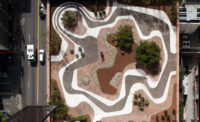Robert Burle Marx and Brazil's Modern Landscapes

Roberto Burle Marx Lectures: Landscape as Art and Urbanism, edited by Gareth Doherty. Lars Müller Publishers, 288 pages, $35.

Depositions: Roberto Burle Marx and Public Landscapes Under Dictatorship, by Catherine Seavitt Nordenson. University of Texas Press, 336 pages, $45.


Born in São Paulo in 1909 to a Brazilian mother and a German father, Roberto Burle Marx (distant cousin of Karl) was a self-taught botanist and trained painter. Fusing a deep reverence for nature with love of the arts, he designed many of Brazil’s most celebrated public parks, plazas, and gardens during the middle of the 20th century. He was known for the asymmetric and organic forms of his landscapes—incarnations of his abstract, Matisse-like paintings—and his collaborations with architect Oscar Niemeyer, especially the 1962 Palácio da Justiça in Brasília. The symbiosis of Niemeyer’s curved concrete forms and Burle Marx’s meandering compositions of native flora would come to define the country’s tropical Modernist style, but Burle Marx’s physical creations are only part of his genius. His speeches, many translated into English for the first time, appear in two recent books—one assembled by Catherine Seavitt Nordenson, the other by Gareth Doherty—reveal a prescient thinker, who warned of climate change, as well as a passionate urbanist concerned with the well-being of city dwellers. He was also, however, a loyal counselor to the brutal 21-year regime that began with a 1964 coup and killed, exiled, and detained thousands—an irony that forms the crux of Seavitt Nordenson’s analysis in Depositions: Roberto Burle Marx and Public Landscapes Under Dictatorship.
Depositions comprises 18 written statements delivered by Burle Marx between 1967 and 1974 to the dictatorship’s Ministry of Education and Culture. Seavitt Nordenson organizes these pieces—addressing deforestation, land conservation, and botanic gardens—into thematic groupings, each anchored by sociopolitical context and commentary and rare archival photographs. The author skillfully weaves a narrative about Burle Marx into a turbulent history defined by an empire, a republic, a democracy, and two military juntas, highlighting his four-decades-long ties to the political elite and his role in shaping a state-sponsored national culture. But Seavitt Nordenson also argues that Burle Marx, although conservative, actually opposed the military regime, and that he leveraged his position, compromised though it may have been, to protest the government’s ecologically destructive economic-development strategies—a bold move by him, considering the 1964 regime’s intolerance of dissent.
Seavitt Nordenson’s volume is as much about the political construction of modern Brazil as it is about Burle Marx. Gareth Doherty’s Roberto Burle Marx Lectures: Landscape as Art and Urbanism can be best described as a tribute to a brilliant designer and his ideas. In his book, Doherty, who worked in Burle Marx’s studio for a short time after his subject died in 1994, includes 12 of Burle Marx’s lectures, from 1954 and 1986, delivered at institutions such as Harvard University, MIT, and the American Society of Landscape Architects. They are bookended by glossy photographs, including stunning aerial views of the biomorphic motifs of Burle Marx’s seminal works, including the 1951 Parque Jaqueira in Recife and the 1970 Copacabana Beachfront in Rio de Janeiro.
Burle Marx recycled and adapted his speeches over the years, so the two books do overlap. But the distinction in audience and circumstances surrounding each collection—official sessions with a murderous government versus intellectual meetings at democratic institutions—yield vastly different tones. Pleading to the dictatorship to protect Brazil’s ecological diversity, many of Burle Marx’s depositions reveal his anguish in a masterful blend of pathos, ethos, and logos. His lectures to American audiences are more philosophical musings: a discussion about garden lighting digresses into a history lesson that touches on the Impressionists, Afro- Brazilian rituals, and the Counter-Reformation.
Depositions offers an understanding of Burle Marx beyond his gardens and parks; it is a solid introduction to both his work and Brazil’s quest to establish its cultural identity. With less context, the lectures might be best enjoyed by those already familiar with him. But both publications illuminate his astuteness, approaching clairvoyance, still pertinent today.









